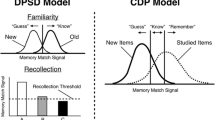Abstract
High-functioning autistic individuals were compared with age-matched normal control subjects on a visual recognition memory task. In order to evaluate the effects of “meaning” and“delay” on the visual memory of autistic individuals, meaningful (pictures) and meaningless (nonsense shapes) stimuli were presented visually in no delay and 1-minute delay intervals to both groups. It was concluded that autistic subjects perform particularly poorly on meaningless materials, but they are able to utilize meaning to aid their visual memory. Contrary to expectations, 1-minute delay intervals did not differentially affect the visual memory performance of autistic individuals compared to control subjects. The results do not support the idea of a simple parallel between autism and mediotemporal lobe amnesias. The visual memory performance of the autistic subjects was discussed in the light of the possibility of a subtle involvement of the mediotemporal brain structures and inflexible cognitive strategies poorly suited to encode novel information.
Similar content being viewed by others
References
American Psychiatric Association. (1980).Diagnostic and statistical manual of mental disorders (3rd ed.). Washington DC: Author.
Ameli, R. (1986).:Visual memory processes in nonretarded individuals with autism. Doctoral dissertation, California School of Professional Psychilogy, San Diego.
Bartak, L., & Rutter, M. (1976). Differences between mentally retarded and normally intelligent autistic children.Journal of Autism and Childhood Schizophrenia, 6, 109–122.
Bauman, M., & Kemper, T. (1985). Histoanatomic observations of the brain in early infantile autism.Neurology, 35, 866–874.
Benton, A. L. (1974).Revised Visual Retention Test (4th ed.). New York: Psychological Corp.
Boucher, J., & Warrington, E. K. (1976). Memory deficits in early infantile autism: Some similarities to the amnestic syndrome.British Journal of Psychology, 67, 73–87.
DeLong, R. (1978). A neuropsychologic interpretation of infantile autism. In M. Rutter & E. Schopler (Eds.),Autism: A reappraisal of concepts and treatment (pp. 207–218), New York: Plenum Press.
DeMyer, M., Hingtgen, J., & Jackson, R. (1981). Infantile autism reviewed: A decade of research.Schizophrenia Bulletin, 7, 390–453.
Dixon, W. J., Brown, M. B., Engelman, L., Frane, J. W., Hill, M. A., Jennrich, R. I., & Toporek, J. D. (Eds.). (1981).BMDP statistical software. Berkeley: University of California Press.
Gaffan, D. (1983). Animal amnesia: Som disconnection syndrome? In W. Seifert (Ed.),Neurobiology of the hippocampus (pp. 513–528). New York: Academic Press.
Hauser, S. L., DeLong, G. R., & Roseman, P. (1975). Pneumographic findings in the infantile autism syndrome: A correlation with temporal lobe disease.Brain, 98, 677–688.
Heltzer, B. E., & Griffin, J. L. (1981). Infantile autism and the temporal lobe of the brain.Journal of Autism and Developmental Disorders, 11, 317–330.
Hermelin, B. & O'Connor N. (1970).Psychological experiments with autistic children. Oxford: Pergamon Press.
Kanner, L. (1943). Autistic disturbance of affective contact.Nervous Child, 2, 217–250.
Lincoln, A. J., Courchesne, E., Kilman, B. A., Elmasian, R., and Allen, M. (1988). A study of intellectual abilities in high-functioning people with autism.Journal of Autism and Developmental Disorders, 18, 297–298.
Merjanian, P. (1985).Involvement of the hippocampus and amygdala in autism. Unpublished Doctoral Dissertation, University of California, Irvine.
Mishkin, M. (1978). Memory in monkeys severely impairedby combined but not by separate removal of amygdala and hippocampus.Nature, 273, 297–298.
Murray, E. A., & Mishkin, M. (1985). Amygdalectomy impairs cross-modal association in monkeys.Science, 228, 604–606.
Prior, M. (1979). Cognitive abilities and disabilities in infantile autism: A review.Journal of Abnormal Child Psychology, 7, 357–380.
Prior, M., & Chen, C. S. (1976). Short-erm and serial memory in autistic, retarded, and normal children.Journal of Autism and Childhood Schizophrenia, 6, 121–131.
Ramondo, N., & Milech, D. (1984). The nature and specificity of the language coding deficit in autistic children.British Journal of Psychology, 75, 95–103.
Rutter, M. (1978). Language disorders and infantile autism. In M. Rutter & E. Schopler (Eds.),Autism: A reappraisal of concepts and treatment (pp. 85–104). New York: Plenum Press.
Rutter, M. (1983). Cognitive deficits in the pathogenesis of autism.Journal of Child Psychology and Psychiatry, 24, 513–531.
Shah, A., & Frith, U. (1983). An islet of ability in autistic children: A research note.Journal of Child Psychology and Psychiatry, 24, 613–620.
Sidman, M., Stoddard, L. T., & Mohr, J. P. (1968). Some additional quantitative observations of immediate memory in a patient with bilateral hippocampal lesions.Neuropsychologia, 6, 245–254.
Sigman, M. & Ungerer, J. (1981). Sensorimotor skills and language comprehension in autistic children.Journal of Abnormal Child Psychology, 9, 149–165.
Snodgrass, J. G., & Vanderwart, M. (1980). A standard set of 260 pictures: Norms for name agreement, image agreement, familiarity, and visual complexity.Journal of Experimental Psychology: Human Learning and Memory, 6, 174–215.
Squire, L. (1986). The neuropsychology of memory dysfunction and its assessment. In I. Grant & K. M. Adams (Eds.),Neuropsychological assessment of neuropsychiatric disorders. New York: Oxford University Press.
Tager-Flusberg, H. (1985). The conceptual basis for referential word meaning in children with autism.Child Development, 56, 1167–1178.
Wechsler, D. (1974).Wechsler Intelligance Scale for Children—Revised. New York: Psychological Corp.
Wechsler, D. (1981).Wechsler Adult Intelligence Scale—Revised. New York: Psychological Corp.
Wing, L. (1976). Diagnosis, clinical descriptions, and rognosis. In L. Wing (Ed.),Early childhood autism: Clinical, educational, and social aspects (2nd ed., pp. 15–52). Oxford: Pergamon.
Wilhelm, H., & Lovaas, O. (1976). Stimulus overselectivity: A common feature in autism and mental retardation.American Journal of Mental Deficiency, 81, 26–31.
Zola-Morgan, S., & Squire, L. R. (1985). Medial temporal lesions in monkeys impair memory on a variety of tasks sensitive to human amnesia.Behavioral Neuroscience, 99, 22–34.
Author information
Authors and Affiliations
Additional information
This research was supported by NIMH grant 1-R01-MH36840 and NINCDS grant 5-R10-NS19855 awarded to E. Courchesne.
Rights and permissions
About this article
Cite this article
Ameli, R., Courchesne, E., Lincoln, A. et al. Visual memory processes in high-functioning individuals with autism. J Autism Dev Disord 18, 601–615 (1988). https://doi.org/10.1007/BF02211878
Issue Date:
DOI: https://doi.org/10.1007/BF02211878




